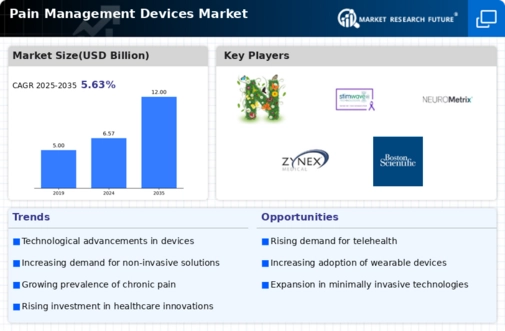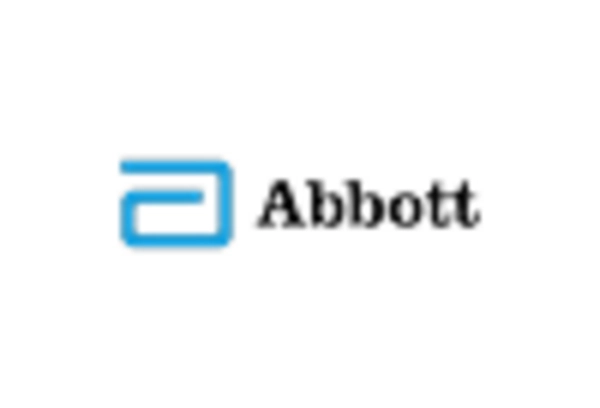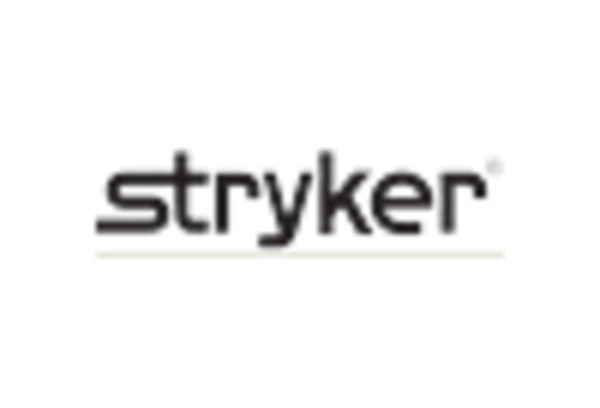Aging Population
The aging population is another critical factor influencing the Pain Management Devices Market. As individuals age, they often experience an increase in chronic pain conditions, including arthritis and degenerative diseases. The demographic shift towards an older population is expected to drive demand for pain management solutions. By 2030, it is anticipated that the number of individuals aged 65 and older will reach approximately 1.5 billion, creating a substantial market for pain management devices. This demographic trend suggests that healthcare systems will increasingly rely on advanced pain management technologies to address the needs of older patients. Consequently, the Pain Management Devices Market is likely to witness significant growth as manufacturers develop devices tailored to the unique requirements of this demographic.
Rising Healthcare Expenditure
Rising healthcare expenditure is a significant driver for the Pain Management Devices Market. As countries invest more in healthcare infrastructure and services, there is an increasing focus on pain management solutions. This trend is particularly evident in regions where healthcare systems are evolving to prioritize patient-centered care. Increased funding for pain management programs and devices is likely to enhance accessibility and affordability for patients. Furthermore, as healthcare providers recognize the importance of effective pain management in improving patient outcomes, the demand for pain management devices is expected to rise. The Pain Management Devices Market stands to benefit from this trend, as higher healthcare expenditure translates into greater investment in innovative pain management technologies.
Rising Prevalence of Chronic Pain
The increasing prevalence of chronic pain conditions is a primary driver for the Pain Management Devices Market. Conditions such as arthritis, fibromyalgia, and neuropathic pain affect millions of individuals worldwide. According to recent estimates, nearly 20 percent of adults experience chronic pain, which necessitates effective pain management solutions. This growing patient population is likely to propel demand for innovative pain management devices, as healthcare providers seek to offer effective treatments. The Pain Management Devices Market is expected to expand significantly as a result, with projections indicating a compound annual growth rate of over 8 percent in the coming years. As more patients seek relief from chronic pain, the market for devices designed to alleviate discomfort is poised for substantial growth.
Technological Innovations in Pain Management Devices
Technological innovations are transforming the Pain Management Devices Market, leading to the development of more effective and user-friendly devices. Advancements in areas such as neuromodulation, wearable technology, and telehealth are enhancing the capabilities of pain management devices. For instance, devices that utilize electrical stimulation or biofeedback mechanisms are becoming increasingly popular due to their non-invasive nature and effectiveness. The integration of smart technology allows for real-time monitoring and personalized treatment plans, which may improve patient outcomes. As these innovations continue to emerge, the Pain Management Devices Market is likely to experience robust growth, driven by the demand for cutting-edge solutions that cater to diverse patient needs.
Increased Awareness and Acceptance of Pain Management Solutions
There is a growing awareness and acceptance of pain management solutions among both healthcare providers and patients, which serves as a significant driver for the Pain Management Devices Market. Educational initiatives and advocacy efforts have contributed to a better understanding of chronic pain and its impact on quality of life. As a result, patients are more likely to seek out effective pain management options, including devices that offer non-invasive or minimally invasive treatments. This shift in perception is likely to enhance the market landscape, with an increasing number of healthcare professionals recommending pain management devices as part of comprehensive treatment plans. The Pain Management Devices Market is expected to benefit from this trend, as more patients embrace innovative solutions to manage their pain.


















Leave a Comment